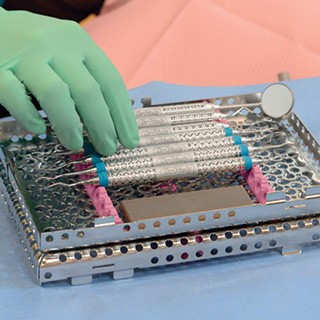Blog
Q&A: Dr. Roger Levin on Adapting to Our Next Normal

Strategies and Advice for Navigating Changes to Your Practice
We asked Dr. Roger Levin of the Levin Group, dentistry's leading practice management and marketing consulting firm, to join our blog for a two-part question-and-answer series exploring the realities of practice management in the COVID-19 world. Check out Part One below for Roger’s take on adapting your practice in a pandemic.
In disruptive events in dentistry like COVID-19, where do you turn to for information and where do you see the light at the end of the tunnel for dental professionals?
COVID-19 has changed almost everything. As a third-generation dentist I have observed first-hand many changes in dentistry, but the current environment stands out. Never have we basically shut down our profession for an extended period and then simultaneously faced a health scare and a financial recession as we start to reopen. Uncertainty rules the day. In the past we could turn to data for help in guiding our decision making. Unfortunately, the data that was so valuable prior to the pandemic has very little bearing on what is happening today, as the conditions are changing so rapidly.

Practices must also take care to separate fact from fiction. When listening to experts regarding data surrounding the COVID-19 crisis and its effects on dentistry, be sure to determine whether the data is based on research or general opinion. One of the best sources of research-based information is the ADA and the ADA Health Policy Institute. The ADA has published many valuable resources to help guide practices through this challenging time, and the ADA-HPI team has been collecting and analyzing practice-related data from the very start of the pandemic and issuing weekly reports as well as continuously updating their interactive website. Organizations such as The Levin Group Data Center (the data collection arm of Levin Group Consulting) collect data and offer that information in articles and webinars. Other leading companies in our profession have come forward to support practices with information and tools to guide them. The “Back to Practice” resource center from HuFriedyGroup and the wide variety of practical tips and tools it contains on infection control, aerosol management, and patient communication, is a great example.
Every practice is obviously unique, but to help practices navigate these challenging times and obtain a sense of where they might be in relation to the overall profession, Levin Group has developed a 24-month recovery timeline that consists of three phases. Phase One (months one to four) represents a time of pent-up demand when practices will be extremely busy. Phase Two (months five to 12) represents a time of declining production when practices are likely to see a production slowdown, health scares, and economic recession. Phase Three (months 13–24) is the recovery phase when practices can gradually build back up to a higher level of production.
While it is understandable to be cautious as we move through the COVID-19 recovery, fear can be a debilitating factor. For example, practices that focused during the abrupt shutdown on getting ready for the reopening (versus sitting in fear) had excellent months in June and July. Many set all-time monthly revenue records. We advise our clients to minimize the disruption that fear can cause by creating a specific written plan and using it to guide decisions and actions. This cuts down on “overthinking” every decision and it helps reduce the impact of negative occurrences. Stay focused on what you decide is best for your practice and worry less about what is outside of your control.
The good news is that there definitely is light at the end of the tunnel. There are approximately 130 companies throughout the world working on vaccines and therapeutics.
Now that most practices have returned in some form or another, what new realities do you feel stand out the most? What are the implications of those changes and do you feel practices have adapted appropriately?
For the most part, dental practices are experiencing a lower volume of patients due to the new infection control and health safety recommendations. As practices are becoming more comfortable viewing infection control as a standardized system in the practice, the volume factor is improving. Dental practices have always had the opportunity to increase patient volume, most by 30–50 percent. But that just didn’t seem to matter as much when practices were performing at a higher level. It is now critical for practices to take advantage of opportunities to increase volume and practice efficiency.
Production is the number-one factor that practices should focus on to ensure a successful recovery. Consider these three things to help your practice to improve quickly in this area:
- Review all operational systems and retrain staff. This is a time where there is no room for waste or inefficiency. Certain activities must take place daily such as reactivation of overdue patients, following up on treatment presentation, collecting any overdue accounts, and ensuring the right reimbursements from dental insurance companies. It is important to refresh every team member’s training level, especially on the items listed above.
- Eliminate unproductive chair time. No-shows, for example, must be reduced to under one percent. Procedures such as post-operative exams and some case presentations can be moved to a virtual platform. The reality is that chair time needs to be reserved for productive procedures.
- Measure the most important factors. There are only eight key performance indicators that really matter in recovery. They are production, collection, revenue, expenses, number of overdue patients, active patients, new patients, and doctor income. Except for doctor income, these should all be measured daily and discussed with the team.
Remember, practices that have a true sense of urgency about reorganizing how they work can increase productivity and volume quickly.
This challenging time also presents opportunities that may not have otherwise surfaced. Whenever there is a crisis there is also disruption. Harvard professor and businessman Clayton Christensen wrote the best-known book on this subject, The Innovator’s Dilemma, in 1997, and its lessons apply today. Disruption creates new opportunities. Innovative practice owners might take advantage of the current conditions to hire high-quality team members who had to leave other practices. Or some might look to acquire another practice that unexpectedly becomes available at a reasonable cost. Practices should be forward thinking and look for opportunities, especially now.
You have recently said that the Holy Grail for COVID-19 recovery comes down to the following concepts: revenue, volume, efficiency, and automation. Can you expound on that and offer some specific suggestions on how to approach this?
Efficiency, efficiency, efficiency. That will become the new mantra in dental practices in 2020. In 2019, one of the best economic years in United States history, most practices did well. Still, they weren’t taking advantage of all the opportunities that were available. One big opportunity is to use technology to decrease the number of steps it requires to complete a task, increase the speed of any practice duty, enhance overall practice communication, and decrease mistakes.

I can point to the Instrument Management System (IMS™) for organization and sterilization as an example. This technology has many positive benefits, but most importantly in today’s environment is that is saves time and increases efficiency. This allows the dentist and the team to focus on patient care, communication, and customer service. It’s an excellent example of a technology that saves time and reduces steps and mistakes.
Ultimately, practice recovery is about four interrelated things. Production leads to revenue, revenue leads to cash, and cash leads to income. By identifying the best strategies and increasing efficiency, practices can more easily progress through this simple formula. It’s also important to note that practices with cash are protected for the future. There’s an old expression that “cash is king,” and it has never been truer. Practices with cash will survive and be very successful again; conversely, businesses without enough cash will have to borrow or make other arrangements. Production is not simply about trying to make as much money as possible for the practice. It’s about creating the first step in a formula that will also protect the practice for the future.
Dr. Levin will return for Part Two of this series to answer questions related to evolving dental teams, patient concerns, and effective external communication.

About Roger Levin, DDS
Dr. Roger P. Levin is the CEO of Levin Group, a leading dental management consulting firm. Founded in 1985, Levin Group has worked with over 30,000 dental practices. Dr. Levin is one of the most sought-after educators in dentistry and is a leading authority on dental practice success and sustainable growth. Through extensive research and cutting-edge innovation, Dr. Levin is a recognized expert on propelling practices into the top 10 percent. He has authored 65 books and over 4,000 articles on dental practice management and marketing.
All company and product names are trademarks of Hu-Friedy Mfg. Co., LLC its affiliates or related companies, unless otherwise noted.

